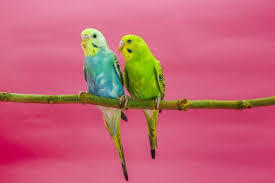Addressing Excessive Mating Behavior
If your pet bird is experiencing excessive mating behavior, it is important to start by reassessing its environment. Understanding the conditions in which your bird is living is key to preventing this behavior.
Breeding Once a Year is Natural
Wild birds live in harsh natural environments, and large parrots in the wild typically breed only once a year. Although they are the same species, there are significant differences between the environments of wild large parrots and those kept in captivity. Ideally, parrots in captivity should also have their mating behavior limited to once or twice a year, closely resembling their natural cycles.
Living Without Threats
Birds kept in homes have access to clean water and well-balanced food every day, and they do not face the dangers of hunger or predators. In fact, they often receive daily treats. There are no reptiles or birds of prey threatening them, and they are shielded from harsh weather. The constant temperature and humidity inside the house are likely very comfortable for companion birds. However, this “perfect environment for breeding” can actually trigger excessive mating behavior.
The Influence of Human Companionship
Companion birds that form strong bonds with their owners are often in a constant state of readiness to mate. The more frequent and affectionate the interaction with their beloved owner, the more likely the bird is to exhibit mating behavior. In the wild, parrots increase physical contact with their mate during breeding season, leading to mating, egg-laying, and rearing of chicks. However, for many companion birds, the “partner” becomes the owner, and daily interactions may inadvertently encourage mating behavior.
Impact of Daylight Duration
In commercial poultry farms, light management is used to stimulate egg-laying. By keeping artificial lights on longer, the hens’ egg production is boosted. Similarly, pet birds that live in environments where daylight hours are prolonged due to human activity may experience disrupted mating cycles. Birds originating from regions with distinct seasonal changes, such as Eclectus parrots, Galah cockatoos, and other parrots from Oceania, are particularly sensitive to light cycles, which are closely tied to their mating behavior.
Toys and Mating
Toys are an essential part of a pet bird’s life, adding stimulation and color to their environment. However, some birds may develop mating behavior towards certain toys. Birds may show mating tendencies towards plush toys with feather-like textures, hard toys resembling a beak, or even mirrors. If this behavior continues, it’s best to remove the items that are causing the issue. Additionally, an overabundance of toys in the cage can also encourage excessive mating behavior, so moderation is key.
Problems Caused by Excessive Mating Behavior
For Females:
- Overstimulation from excessive physical contact may increase their desire to breed.
- Frustration from unmet breeding desires can lead to aggressive behavior, feather plucking, or self-harm.
- Repeated mating and egg-laying can result in egg binding, calcium deficiency, or exhaustion.
For Males:
- Mating behavior can lead to aggression, and frustration from unmet desires may also cause feather plucking or self-harm.
- Repeated mating attempts can cause injuries, such as bleeding from the cloaca.
- Chronic mating behavior may result in enlarged testes and an increased risk of tumors.
How to Control Excessive Mating Behavior
A mating cycle of once or twice a year is natural and not usually a cause for concern. However, frequent mating beyond this can lead to various health issues. To promote a long and healthy life for your bird, it’s important to take steps to control excessive mating behavior.
- Limit high-calorie and high-fat foods:
Feeding your bird too many fatty nuts or sugary fruits can lead to obesity and stimulate mating behavior. Many store-bought fruits are artificially enhanced to be sweeter than wild fruits, so moderation is necessary to prevent weight gain. - Reduce daylight hours:
Long periods of daylight can disrupt a parrot’s mating cycle. Aim to replicate natural daylight patterns as closely as possible. At night, move the bird to a quiet, dark area or cover the cage with a light-blocking cloth to ensure they get enough rest. - Avoid overprotectiveness:
While it’s not wrong to adjust your bird’s environment for comfort, being overly protective can have negative effects. Parrots are more likely to mate in warmer conditions, so avoid keeping them too warm.
By implementing these strategies, you can help reduce excessive mating behavior and keep your bird healthy.



Comments